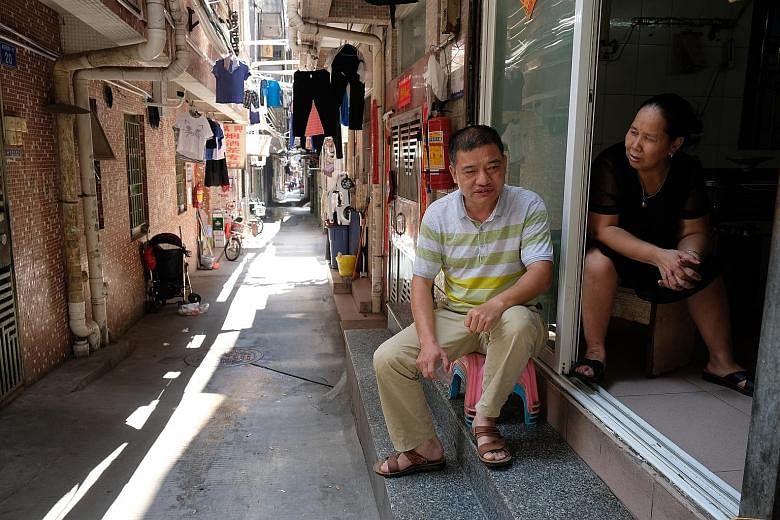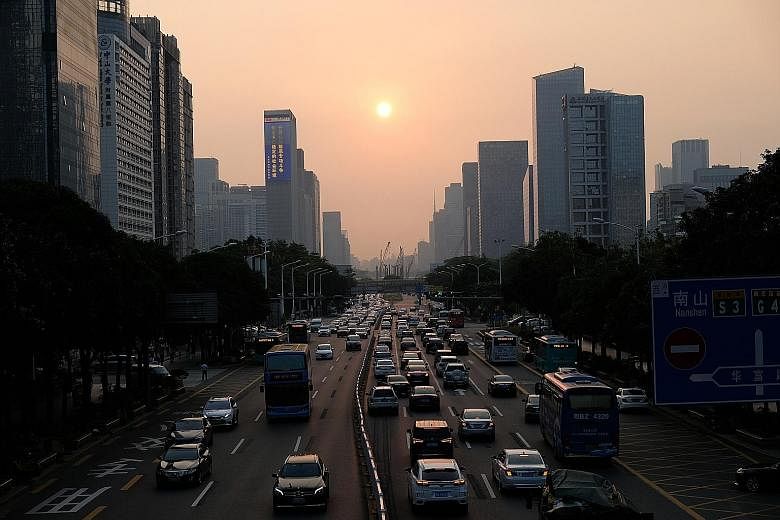When Mr Xie Yifa arrived in Shenzhen 26 years ago, it was a very different city. Then, the Nantou village where he lived - one of several that dotted the nascent metropolis - was criss-crossed by dirt tracks, which would become a wet slurry when it rained.
Today, butcher and provision shops still hawk their wares along the narrow alleys, now paved with concrete. The city - once just fields, hills and saltpans interspersed with farming and fishing villages - is a jungle of glass and concrete.
Said the 46-year-old contractor: "So much has changed, you look around and there are skyscrapers everywhere."
Shenzhen was an experimental field for China's economic reforms which began in 1978. Then, Communist Party elders led by Deng Xiaoping launched China's reform and opening up policy with the goal of transforming the country's centrally planned economy to one that was more market-driven.
Shenzhen was picked as one of four special economic zones (SEZs) along the southern coast to pilot market-oriented policies - the others being Zhuhai and Shantou, also in Guangdong province, and Xiamen in nearby Fujian province.
Manufacturers, many from across the border in Hong Kong, came - attracted by tax breaks and the mainland's plentiful labour.
In four decades, Shenzhen has transformed from a collection of rural villages of 300,000 people, to a mega-city with an estimated population of 20 million, and a gross domestic product of 2.24 trillion yuan (S$446 billion), the third-highest for a city in China after Shanghai and Beijing.
CITY OF MIGRANTS
-
FOUR DECADES LATER...
-
The biggest story of the turn of the 21st century must be the transformation of China into the world's No. 2 economy.
Three decades of relative isolation, including 10 chaotic years during the Cultural Revolution of 1966-1976, had left the country backward and impoverished.
However, in the 40 years since China, under patriarch Deng Xiaoping, first embarked on reforms and opened up to the outside world in 1978, it has lifted more than 800 million Chinese out of poverty.
The Chinese people's lives have improved not only materially. They have also gained more civil rights and freedoms. The loosening of the hukou or residential permit system has meant that they are able to move freely in the country and go where the jobs are. But reform of the system is not complete, so migrant workers in the cities cannot enjoy the social benefits that permanent city residents do. The people's increased social space includes some leeway to practise religion.
But development has not come without costs.
The harsh one-child policy, started in 1980 to slow down population growth and speed up economic development, has caused undue pain to couples who want more than one child. It has also led to a distortion in the gender ratio, a rapidly ageing society and a shrinking workforce that could threaten economic growth and social stability. The government has relaxed the policy, with families now allowed to have two children.
Four decades of unfettered growth have also damaged the land, with air, water and soil pollution so severe in some areas that the incidence of diseases like cancer and premature deaths is high. Uneven development of the different regions has also meant higher inequality and pockets of extreme poverty.
After 40 years of reform and opening up, there is also a sense that the government is tightening up control again - not only of the economy but also of the social sphere.
There is a certain amount of uncertainty over which way China will go in the decades to come, whether it will continue to liberalise its economy and society - or otherwise.
Still, the past 40 years have been nothing short of a miracle for the Chinese people in terms of the economic and social transformation that has brought wealth and some freedoms to them.
In the stories that follow, The Sunday Times' correspondents in China highlight some of the key policy changes and the transformations these have brought.
Shenzhen's success has been hailed by state media, but its fortunes were built on the backs of ordinary Chinese - migrants from all over the country such as Mr Xie, who took a chance and came seeking a better life.
This diverse fabric is made plain in the "urban villages" within the metropolis like the one Mr Xie lives in. In a single street, there are shops selling noodles from the north-western city of Lanzhou, Chongqing hotpot, and smelly tofu from central Hunan province. The city's lingua franca is not Cantonese like elsewhere in Guangdong province, but putonghua, or Mandarin.
Urban villages came about because while the city's officials acquired farmland for development, they left the farmers' residential land - their villages - alone. Farmers developed housing on these plots that they rented cheaply to migrants, providing much-needed affordable housing and other amenities to workers on low wages.
Mr Xie arrived in Shenzhen in 1992, the same year Deng completed his landmark Southern Tour of Wuchang, Shenzhen, Zhuhai and Shanghai, where he threw his weight behind economic reforms. The country's reforms had stalled in the aftermath of the June 4, 1989 Tiananmen incident in which hundreds - possibly thousands - died in the crackdown on pro-democracy demonstrations in Beijing. Deng's Southern Tour revitalised the reforms.
"In the 1970s, it was very different, people lived and worked in collectives. But with the reform and opening up, we had a choice to make a living for ourselves," said Mr Xie, who is from Ganzhou in Jiangxi province. In Shenzhen, he worked for a decade in a factory making plastic casings for electronics, and saved up enough money to set up his own renovation business, employing up to 10 workers each time he gets a project.
"How long will I stay here? I don't know, but I know in Shenzhen there will be opportunities, it just depends on whether you can grasp them," he said.
Millions of others thought so too, and crammed into the city, where they fuelled the economic boom.
THE HONG KONG FACTOR
Another factor responsible for Shenzhen's success is its proximity to Hong Kong, from which it drew ideas, capital and technology.
This was evident in Shekou, the first free-market industrial area set up in Shenzhen.
"When the Shekou Industrial Zone was being built, its way of management and the talents that ran the place were from Hong Kong," said Mr Brian Chen, who runs TAS, a social organisation that gives educational talks on Shekou's history.
The zone's founder, Communist Party cadre Yuan Geng, also learnt a thing or two about the free market when he was trying to get investors in Hong Kong to invest in the area.
"Shekou has a well-known slogan - Time is money, efficiency is life - the first part of the slogan is something Yuan Geng learnt dealing with investors in Hong Kong," said Mr Chen.
Professor Li Jinkui, senior research fellow at the China Development Institute, a Shenzhen-based think-tank, noted that in the days before reforms began, Shenzhen was still a farming society.
It was a far cry from Hong Kong which - ruled by the British as a colony from 1841 to 1997 - was an advanced industrialised society, with access to Western tech-nology and capital.
He compared this difference to a "waterfall between civilisations" - once the doors were open, technologies and capital rushed in like water and, coupled with the plentiful labour on the mainland, powered the growth of Shenzhen.
"Of the four SEZs, Shenzhen is the closest to Hong Kong, and this favourable position gave it a rare advantage," said Prof Li.
These factors led Shenzhen's GDP to grow a ferocious 22.6 per cent annually on average from 1979 to 2016, and last year it grew 8.8 per cent, higher than the national growth rate of 6.9 per cent.
PRICE OF PROGRESS
But the city's progress has also left some people trying to catch up.
Madam Shen Xia, 38, who makes a living selling yellow wine in Nantou, said her rent has increased five-fold since she came to Shenzhen in 2001.
"The city is getting too expensive for migrants like me. If it keeps going up, I think I will have to go home," said Madam Shen, who is from Meizhou, another city in the same province.
Other migrants have also paid a price for helping build a city from nothing.
More than 600 workers from neighbouring Hunan province are petitioning the city's government for compensation. They had developed silicosis, an incurable lung disease caused by prolonged inhalation of airborne silica dust, when working on construction projects in Shenzhen.
Even so, the city has not lost its attraction - it continues to pull in people from all over China, these days often professionals in its technology or financial sector.
"Most of the people here are originally from elsewhere, so Shenzhen is inclusive, it's a city of young people, not like Beijing or Shanghai," said computer systems engineer Chen Yongbin, 28, explaining why he came to Shenzhen from Jiangxi province five years ago.
Mr Chen, who has two children, has put down roots in Shenzhen and said he intends to stay for the long haul.
The poet Lu Xun compared hope to a path in the countryside - where once there was no path, after people begin to pass, a way appears.
For 40 years, millions in China have been drawn south to Shenzhen by the economic reforms that began there.
The city might have once been a muddy country road, but for the efforts of Mr Chen and the millions of others who came before him, it is now a wide boulevard.



